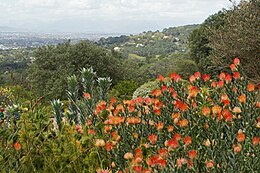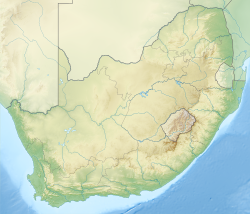Cape Floristic Region
| UNESCO World Heritage Site | |
|---|---|
 | |
| Location | South Africa |
| Includes |
|
| Criteria | Natural: (ix), (x) |
| Reference | 1007bis |
| Inscription | 2004 (28th Session) |
| Extensions | 2015 |
| Area | 1,094,742 ha (2,705,170 acres) |
| Buffer zone | 798,514 ha (1,973,170 acres) |
| Coordinates | 34°10′00″S 18°22′30″E / 34.16667°S 18.37500°E |
The Cape Floral Region is a
The Cape Floristic Region, the smallest of the six recognised
Location and description
Home to the greatest non-tropical concentration of higher plant species in the world, the region is the only hotspot that encompasses an entire floral kingdom, and holds five of South Africa's 12 endemic plant families and 160 endemic genera. Covering 78,555 km2, Cape Floristic Region hotspot is located entirely within the borders of South Africa.
It is one of the five temperate Mediterranean-type systems on the hotspots list, and is one of only two hotspots that encompass an entire floral kingdom (the other being New Caledonia)[citation needed].
The Region covers the Mediterranean climate region of South Africa in the Western Cape in the southwestern corner of the country, and extends eastward into the Eastern Cape, a transitional zone between the winter rainfall region to the west and the summer-rainfall region to the east in KwaZulu-Natal.
Flora


Most of the region is covered with
According to Takhtajan (1978), the following families are endemic or subendemic to the region:
is produced out of this region.Vegetation types
List of
- Atlantis Sand Fynbos – Vegetation type from north of Cape Town, in the Western Cape, South Africa
- Boland Granite Fynbos – Vegetation type endemic to the Western Cape, South Africa
- Cape Flats Dune Strandveld – Endangered vegetation type endemic to the coastal areas around Cape Town
- Cape Flats Sand Fynbos – Vegetation type endemic to the City of Cape Town
- Cape Lowland Freshwater Wetland – Vegetation type endemic to the Western Cape, South Africa
- Cape Winelands Shale Fynbos – Vegetation type endemic to the Boland of the Western Cape, South Africa.
- Hangklip Sand Fynbos – Vegetation type endemic to the southern coastal portion of the Western Cape, South Africa
- Kogelberg Sandstone Fynbos – Vegetation type endemic to the far south of the Western Cape, South Africa
- Lourensford Alluvium Fynbos – Vegetation type that is endemic to Cape Town, South Africa
- Peninsula Granite Fynbos – Vegetation type endemic to the city of Cape Town, South Africa
- Peninsula Sandstone Fynbos – Vegetation type endemic to the Cape Peninsula in Cape Town, South Africa
- Peninsula Shale Renosterveld – Vegetation type found only in South Africa
- Southern Afrotemperate Forest – Main indigenous forest-type in the south-western part of South Africa
- Swartland Alluvium Fynbos – Vegetation type endemic to the high plains and mountains in the Western Cape, South Africa
- Swartland Alluvium Renosterveld
- Swartland Granite Renosterveld
- Swartland Shale Renosterveld – Vegetation type endemic to the Western Cape, South Africa
- Swartland Silcrete Renosterveld
Ecology
The
The fynbos ecoregions are designated one of the Global 200 priority ecoregions for conservation. Conservation International declared the Cape floristic region to be a biodiversity hotspot.
It is thought that the Cape Floristic Region is experiencing one of the most rapid rates of extinction in the world due to
World Heritage Site

In 2004, the "Cape Floral Region Protected Areas" were inscribed as a World Heritage Site. The site includes eight representative protected areas:
- Table Mountain National Park
- Cederberg Wilderness Area
- Groot Winterhoek Wilderness Area
- Hottentots Holland Nature Reserve, Kogelberg Nature Reserve)
- De Hoop Nature Reserve
- Boosmansbos Wilderness Area
- Swartberg Complex (Swartberg Nature Reserve, Gamkapoort Nature Reserve, Towerkop Nature Reserve)
- Baviaanskloof Mega Reserve
References
This article incorporates CC BY-3.0 text from the reference[1]
- ^ ISSN 2071-0771.
- ^ Тахтаджян А. Л. Флористические области Земли / Академия наук СССР. Ботанический институт им. В. Л. Комарова. — Л.: Наука, Ленинградское отделение, 1978. — 247 с. — 4000 экз. DjVu Archived 5 October 2018 at the Wayback Machine, Google Books.
- ^ Takhtajan, A. (1986). Floristic Regions of the World. (translated by T.J. Crovello & A. Cronquist). University of California Press, Berkeley, PDF, DjVu.
- ^ "Vegetation Types". Archived from the original on 24 August 2013. Retrieved 24 February 2014.
- ^ "Vegetation Types". Archived from the original on 4 April 2012. Retrieved 7 January 2011.
- ^ South African Press Association (14 August 2014). "Cape is world's extinction capital". Retrieved 20 August 2014.



